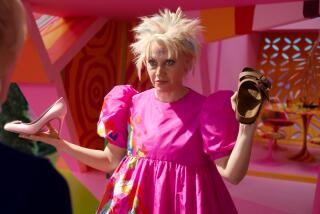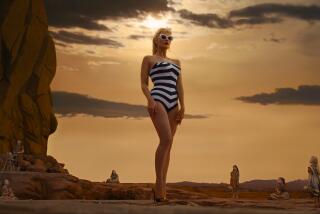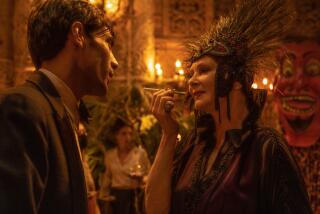Window Dressing : Mannequins have evolved. No longer primitive stiffs, these sculptured and abstract creatures can have as much fun as the next guy--without messing up their clothes.
- Share via
For mannequins, life used to be one long bad hair day. Stuck in gawky poses day in and day out, their wigs perched unevenly on their bald heads, mannequins led sorry existences selling clothes. Look at them now. They’re having more fun than most humans. They’re holding barbecues in department store windows. They’re mixing it up at cocktail parties. They’re playing on swings. They’re flying. Mannequins have evolved from primitive-looking, stiff humanoid forms that resembled giant Barbie and Ken dolls to avant-garde, sculptural creatures that can sit, jump, dive, slouch, pose, and literally bend over backward. Some modern mannequins have no hair, some have no facial features and some are missing important body parts. Others are strikingly lifelike, down to the fine pores on their fiberglass skin.
Unlike the frozen dummies of the past, many of today’s mannequins are easy to manipulate. Those whose limbs aren’t made of hard fiberglass can perform various feats such as straddling a bike or playing cards.
Emporio Armani uses mannequins that have no arms, legs or heads. They’ve been cropped to just their torsos.
“We’re using abstract, abbreviated versions of mannequins,” says Cindy Sirko, visual director for all divisions of Armani including the Emporio Armani store in South Coast Plaza, Costa Mesa. Emporio Armani’s mannequins resemble ordinary shirt forms used in department stores, but instead of plain barrel-chested torsos, these are shaped like real bodies complete with chests and muscles.
“Then we stuff the arms and legs (of the clothes) with tissue paper to animate the figure . . .. We make them seated, standing, in every possible attitude,” Sirko says. “An arm can go into a jacket or pocket. You see how fluid the clothes are.”
Windows in the South Coast Plaza store recently showed mannequins wearing jeans with 6-foot inseams so they looked like they were standing on stilts. Regular-size mannequins clung to their legs.
“We do a lot of group activities,” Sirko says. “We’ve had them sitting on swings, and (engaged) in little crowd scenes. In our New York store we actually had them flying in the air--they were stuck in cobwebs for Halloween.
“We’re only limited by our ideas, whereas with the more traditional fiberglass mannequin the only way to change the display is to change the angle you view it,” Sirko says.
While mannequins may cause a chuckle or raise an eyebrow, their role is a serious one. Without them, customers could not appreciate the drape of the clothing on a human figure or how the proportions are supposed to fit, Sirko says.
“You can see if a collar is supposed to be up or down, buttoned to the neck or left open,” Sirko says.
Her mannequins have occasionally been caught in compromising positions. In honor of Father’s Day, the Los Angeles Armani store featured male mannequins with their pants and boxer shorts down where their ankles should be.
“There are no legs so you used your imagination,” Sirko says.
Mannequins have also turned a few heads at Barneys New York. In one memorable scene at the New York City store, mannequins were shown trying to give up smoking.
“One was giving up, one was lighting up, one was trying hypnosis and one was writing down ‘quit smoking’ for her New Year’s resolution,” says Steven Johanknecht, vice president of display for Barneys.
Johanknecht designs mannequins exclusively for Barneys because “they play such a strong role in the interiors.”
“They’re very carefully thought-out. Sometimes stores drop it when it comes to mannequins,” he says.
Barneys’ mannequins tend to look more like sculptures in a museum than people. Their faces, if they have them, are abstract works of art, some with vague noses, mouths and faint depressions where the eyes should be. Most have no paint on their faces at all, except for a group of females who wear only ruby lipstick and streaks of brown for their eyebrows and eyelashes.
“In the ‘80s everyone used realistic mannequins. Now it seems more fresh to use abstract forms,” Johanknecht says. “It focuses more attention on the clothing.”
Mannequins that look uncannily human still inhabit many stores. Adel Rootstein, Inc., a large mannequin manufacturer based in New York City and London, copies their mannequins from live models. Occasionally they copy celebrities, but only those who “have fashion significance,” says Michael Southgate, creative director for Adel Rootstein.
Among those who have been cloned into mannequins: Cher, Twiggy and Joan Collins--before her “Dynasty” days.
“She was already one of the most glamorous mature women in the world. She epitomized power dressing,” Southgate says.
Most Adel Rootstein mannequins are copies of real-life fashion models, who sit for hours at a time to have their “portraits” sculpted out of clay and reproduced in fiberglass. While faces can be duplicated in a few hours, a full-body mannequin requires the subject to be present four hours a day for about three weeks, Southgate says.
“We sculpt from life,” he says. Because they’re made by hand, mannequins don’t come cheap. They cost about $900 each.
Adel Rootstein produces about 20,000 mannequins a year, supplying many of the nation’s major retailers including Neiman Marcus, Bullock’s, Saks Fifth Avenue, I. Magnin and Charlotte Russe.
Notions about beauty change with the times, so mannequins must change as well. Twiggy posed for her mannequin in 1967, a time when voluptuous types like Marilyn Monroe and Jayne Mansfield were being replaced by skinny women with boyish physiques as the feminine ideals.
“The whole perception of beauty and body shape changed,” Southgate says. “Before Twiggy, we couldn’t imagine doing a knock-kneed, flat-chested, pigeon-toed girl.”
These days youthful, natural-looking models who have glowing skin and don’t look made up are the rage.
“They have to look slightly messy or disheveled. Sophisticated is out,” Southgate says. “Now it’s an uncontrived, natural look.”
The new crop of dewy-faced models makes life challenging for Adel Rootstein:
“The more natural (the models) get, the harder they are to duplicate in fiberglass,” Southgate says.






